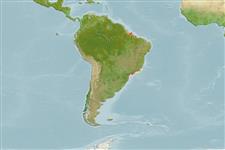Environment: milieu / climate zone / depth range / distribution range
Écologie
marin; saumâtre; profondeur 1 - 22 m (Ref. 189). Tropical; 1°N - 27°S, 51°W - 32°W (Ref. 189)
Southwest Atlantic: mouth of Para River southward to Cananéia, Brazil.
Taille / Poids / Âge
Maturity: Lm ? range ? - ? cm
Max length : 6.8 cm SL mâle / non sexé; (Ref. 189)
Description synthétique
Clés d'identification | Morphologie | Morphométrie
Épines dorsales (Total) : 0; Épines anales: 0; Rayons mous anaux: 22 - 25. Snout short, about 1/2 eye diameter; maxilla shorter than in most other Anchoa species, tip pointed, not reaching beyond hind margin of pre-operculum; gill cover canals of walkeri-type. Pectoral fins large, reaching about pelvic fin origin; anal fin fairly long, its origin below or just before midpoint of dorsal fin base. A silver stripe along flank, less than eye diameter.
Presumably schooling along beaches and down to 22 m. A single specimen was recorded from Coqueiros at the mouth of the Paraguaçu River, thus able to tolerate lowered salinities. More data needed.
Life cycle and mating behavior
Maturities | Reproduction | Spawnings | Egg(s) | Fecundities | Larves
Spawn in school (Ref. 205).
Whitehead, P.J.P., G.J. Nelson and T. Wongratana, 1988. FAO Species Catalogue. Vol. 7. Clupeoid fishes of the world (Suborder Clupeoidei). An annotated and illustrated catalogue of the herrings, sardines, pilchards, sprats, shads, anchovies and wolf-herrings. FAO Fish. Synop. 125(7/2):305-579. Rome: FAO. (Ref. 189)
Statut dans la liste rouge de l'IUCN (Ref. 130435)
Menace pour l'homme
Harmless
Utilisations par l'homme
Pêcheries: sans intérêt
Outils
Articles particuliers
Télécharger en XML
Sources Internet
Estimates based on models
Preferred temperature (Ref.
123201): 22.5 - 28.2, mean 27.3 °C (based on 81 cells).
Phylogenetic diversity index (Ref.
82804): PD
50 = 0.5000 [Uniqueness, from 0.5 = low to 2.0 = high].
Bayesian length-weight: a=0.00513 (0.00232 - 0.01135), b=3.14 (2.96 - 3.32), in cm total length, based on LWR estimates for this Genus-body shape (Ref.
93245).
Niveau trophique (Ref.
69278): 3.3 ±0.4 se; based on size and trophs of closest relatives
Résilience (Ref.
120179): Haut, temps minimum de doublement de population inférieur à 15 mois (Preliminary K or Fecundity.).
Fishing Vulnerability (Ref.
59153): Low vulnerability (10 of 100).
Nutrients (Ref.
124155): Calcium = 544 [282, 1,400] mg/100g; Iron = 2.63 [1.41, 4.91] mg/100g; Protein = 17.1 [14.8, 19.8] %; Omega3 = 0.327 [0.152, 0.686] g/100g; Selenium = 33.6 [14.2, 83.5] μg/100g; VitaminA = 34.9 [10.4, 96.6] μg/100g; Zinc = 2.93 [1.91, 4.41] mg/100g (wet weight);
